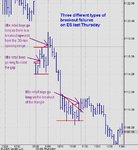Well to be brutally honest, I would never encourage anyone to trade breakouts the way books and courses teach. Because people like me are waiting to fade them as it's usually a very profitable trade.
In other words, I'm looking to get out of my long as you're getting in. The result is usually a nice deep pullback beyond the point of the breakout. You are now in a losing trade and it's dropped below support, so you sell at a loss. And therefore if you don't know what you're doing, trading breakouts is not the thing to do, IMO.
So if you just take one from your list, and really get to know how it forms, when and where it forms, and what happens after it forms, then you'll be well on your way to trading one setup properly.
Now if you want to spend a lot of time and effort in doing your probability/statistics testing, then great. Is the purpose of this to narrow down your list? If it is, you'll still need to understand fully its formation characteristics when your testing has selected the 'ideal' candidate.
Some on your list are intraday, and others are usually used end-of-day, and some can be both - do you realise this? NR7s are EOD, gaps are intraday, etc. Have you decided which timeframe you are going to trade? If you have, this will also reduce the number of types of breakout trades open to you on your list.
I do hope this doesn't sound as if I'm trying to knock you, as I'm not!. I'm just trying to get you to think now about what you're planning to do, so that you won't be faced with disappointment after putting in a lot of effort.
Just to show you what happens when breakouts fail, here's a chart of the emini S&P (ES) on Thursday, which shows how three different types of breakouts failed.

